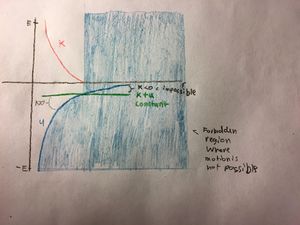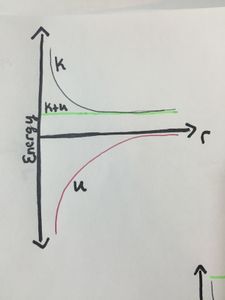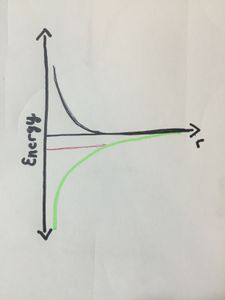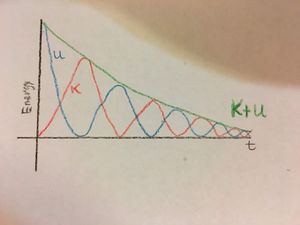Energy Graphs: Difference between revisions
| (47 intermediate revisions by 4 users not shown) | |||
| Line 1: | Line 1: | ||
Claimed by | '''Claimed by Yuntao Liu Fall 2018''' | ||
An energy graph is useful for visualizing the potential and kinetic energy in a system as a function of time or separation distance. This is especially useful when determining if an object is bound to another object. | |||
== | ==The Main Idea== | ||
Energy graphs are extremely useful for analyzing the interactions between two different objects. These graphs can also be confusing if not properly understood. How do all of the different pieces of an energy graph fit together? This page serves as a resource on how to construct and interpret energy graphs. Let's get started! | |||
Energy | |||
'''The Basics''' | |||
Energy graphs are very useful for understanding different repulsive and attractive situations. These graphs consist of three main components: kinetic energy, potential energy, and the kinetic plus potential energy line. These three energies are plotted as a function of energy (y-axis) versus separation between two objects (x-axis). When it comes to spring potential and kinetic energy, energy is graphed as a function of time. | |||
Let's review: | Let's review: | ||
[[Kinetic Energy]] | [[Kinetic Energy]]: the energy that a moving object has in addition to its [[Rest Mass Energy]]. Kinetic energy is '''K''' on an energy graph and has the formula <math>\frac{1}{2}mv^2</math>. | ||
[[Potential Energy]] the energy associated with | [[Potential Energy]]: the energy associated with multi-particle systems. This is the energy between interacting objects, and this energy can be either attractive or repulsive. Potential energy is '''U''' on an energy graph. | ||
'''What is the sum?''' Simply the sum of the potential and kinetic energies displayed on the | '''What is the sum?''' Simply the sum of the potential and kinetic energies displayed on the graph. We will discuss how to plot this value momentarily. '''K+U''' symbolizes the sum of the potential and kinetic energies. This is generally constant when the surroundings are not performing any work on the system (aka when the surrounds are "The Nothing"). However, if there is energy being lost to the surroundings or work being done on the system, then the K+U can change. | ||
'''More Important Tidbits''' | |||
In an '''attractive''' interaction, such as [[Gravitational Potential Energy]], U (potential energy) increases (becomes less negative) and K decreases as two objects move farther away from one another (radius increases). | |||
In a '''repulsive''' interaction, U (potential energy) decreases and K (kinetic energy) increases as the two objects move farther away from one another. When a spring is at equilibrium length after being stretched, kinetic energy is at a maximum. | |||
In an '''attractive''' interaction, U (potential energy) increases (becomes less negative) and K decreases as two objects move farther away from one another. | |||
In a '''repulsive''' interaction, U(potential energy) decreases and K increases as the two objects move farther away from one another. | |||
'''How to Construct an Energy Graph''' | |||
1. Draw U first, based upon whether or not the interaction is attractive or repulsive. | 1. Draw U first, based upon whether or not the interaction is attractive or repulsive. See the examples below in order to visualize how U looks when an interaction is attractive versus repulsive. | ||
2. Choose an r where you know | 2. Choose an r where you know K, and at this point, plot the point (r, K). | ||
3. Add the K value from step 2 to the U value at that same r value. | 3. Add the K value from step 2 to the U value at that same r value. | ||
| Line 41: | Line 36: | ||
5. Draw a horizontal line through this K+U point. | 5. Draw a horizontal line through this K+U point. | ||
6. Find a K value at a different r value that, when added to U, gives K+U (the horizontal line you just drew). | 6. Find a K value at a different r-value that, when added to U, gives K+U (the horizontal line you just drew). | ||
7. With these two points on the K graph, sketch K vs. r. | 7. With these two points on the K graph, sketch K vs. r. | ||
===A | ===A Mathematical Model=== | ||
Kinetic energy can '''NEVER''' be negative! Why? Taking a look at the formula <math>\frac{1}{2}mv^2</math>, while velocity is a vector and can be negative, squaring the velocity results in a positive number. As such, if the object is moving, the kinetic energy is greater than 0, if it is at rest, the kinetic energy is 0. | |||
Potential energy is negative if the interaction is attractive and positive if the interaction is repulsive. | |||
* For spring potential energy, the value is always positive as the spring is always working to counteract a stretch (repulsive). <math>U_s=\frac{1}{2}k_ss^2</math> where s is the stretch and k<sub>s</sub> is the spring constant. | |||
* For electric potential energy <math>U_{ele} = \frac{1}{4\pi\varepsilon_0}\frac{q_1q_2}{\left|r\right|}</math>. Where <math>\frac{1}{4\pi\varepsilon_0}</math>is <math>9\times10^9 \frac{N\cdot m^2}{C^2}</math>, r is the distance between the charges and the q's are the charges. If the change of the two particles have the same sign (both positive or both negative), then the force is repulsive and results in a negative potential energy. If the change of the two particles have different signs (one positive and one negative), then the force is attractive and results in a postie potential energy. | |||
** An electron has a change of -1.6 × 10<sup>−19</sup> C and a proton has a change of 1.6 × 10<sup>−19</sup> C | |||
* For gravitational potential energy <math>U_{grav} = -G\frac{M_1M_2}{\left|r\right|}</math>where G is <math>6.7\times10^{-11} \frac{N\cdot m^2}{kg^2}</math> , M is the mass of the object and r is the distance between the objects. the force is always attractive and the potential energy is negative | |||
== | The sum of the potential and kinetic energies depends on a few factors. If an object can "escape" from an attractive interaction, and, after having escaped, comes to rest some distance away, then K+U is equal to zero. If, however, the object escapes with some final velocity and continues to move, then K+U is greater than zero. Lastly, in a '''bound state,''' an object cannot escape the interaction it is involved in, and K+U is negative. The object will eventually crash into whatever is exerting a force on it. In the figure below, The shaded blue region represents a distance between the two objects that is impossible to achieve (according to classical mechanics. It is sometimes possible to tunnel out of this system under the rules of quantum mechanics, however, that is beyond the scope of this article) as K would then be negative. | ||
[[File:ForbiddenRegion.JPG|300x300px]] | |||
=== | |||
Label K, U, and K+U on the energy | === A Computational Model === | ||
Vpython is great for modeling energy graphs. Using Vpython, we can model many different systems that have kinetic and potential energies. For example, we can model a spacecraft orbiting the Earth, and we can create graphs to display the kinetic, potential, and kinetic+potential energies of this system. See this code for how to model these interactions using Vpython! This specific code shows the spacecraft + Earth system. | |||
* Note: scroll down on the black display window on the right to see the energy graph for this system. | |||
Sample Vpython code:https://trinket.io/glowscript/afe87a7a40 | |||
== Examples == | |||
===Simple=== | |||
'''Question''' | |||
Label K, U, and K+U on the energy graphs for the following situations: | |||
Example 1: | Example 1: | ||
Two electrons are held at rest some finite distance apart, and they move away from each other after they are released. Their initial velocities are zero. | Two electrons are held at rest some finite distance apart, and they move away from each other after they are released. Their initial velocities are zero. | ||
[[File:109.jpg| | [[File:109.jpg|center|300x300px|Example 1]] | ||
Example 2: | Example 2: | ||
A proton and an electron start out far apart. Their initial velocities are nonzero, and their | A proton and an electron start out far apart. Their initial velocities are nonzero, and their interaction is attractive. | ||
[[File:111.jpg| | [[File:111.jpg|center|300x300px|Example 2]] | ||
Example 3: | Example 3: | ||
A daughter has just enough energy to escape from her controlling mother (they have an attractive relationship). | |||
[[File:JDO78.JPG| | [[File:JDO78.JPG|center|300x300px|Example 3]] | ||
'''Solution''' | |||
Example 1: | |||
[[File:Simpleex1solution.JPG|300x300px|Example 1]] | |||
2: A proton and | Example 2: | ||
[[File:Simpleex2solution.JPG|300x300px|Example 2]] | |||
Example 3: | |||
[[File:Simpleex3solution.JPG|300x300px|Example 3]] | |||
===Middling=== | |||
'''Question''' | |||
Label K, U, and K+U on the following energy graphs. THEN, label the following three energy graphs 1, 2, or 3 based on the following scenarios: | |||
1: One of the components of this energy graph is incorrect. | |||
2: A proton and an electron are at rest, and they start out infinitely far apart. | |||
3: An astronaut orbits the moon. | 3: An astronaut orbits the moon. | ||
[[File:JDO78.JPG| | [[File:JDO78.JPG|300x300px|Example 1]] | ||
[[File:JDO100.JPG| | [[File:JDO100.JPG|300x300px|Example 2]] | ||
[[File:Jdo77.jpg| | [[File:Jdo77.jpg|300x300px|Example 3]] | ||
'''Solution''' | |||
Example 1: | |||
K+U is incorrect! | |||
[[File:Intermediateex1solution.JPG|300x300px|Example 1]] | |||
Example 2: | |||
[[File:Intermediateex2solution.JPG|300x300px|Example 2]] | |||
Example 3: | |||
[[File:Intermediateex3solution.JPG|300x300px|Example 3]] | |||
===Difficult=== | |||
'''Question''' | |||
Create an energy graph for each of the following situations. | Create an energy graph for each of the following situations. | ||
Situation 1: A spacecraft is orbiting a moon. The spacecraft is given an initial velocity that allows the spacecraft to leave the moon's orbit with a final velocity greater than zero. | Situation 1: A spacecraft is orbiting a moon. The spacecraft is given an initial velocity that allows the spacecraft to leave the moon's orbit with a final velocity greater than zero. | ||
Situation 2: A boy jumps onto a merry-go-round and is attracted to the merry-go-round's axle. The boy's initial velocity is not | Situation 2: A boy jumps onto a merry-go-round and is attracted to the merry-go-round's axle. The boy's initial velocity is not large enough for him to escape the merry-go-round, so he continues to "orbit" the merry-go-round. | ||
Situation 3: Two people are repulsed by | Situation 3: Two people are repulsed by one another and are trying to fight. They are held at rest by two of their friends a finite distance apart, and they, of course, move away from one another as soon as they are released, since their friends will not let them approach one another. | ||
Situation 4: A spring with a spring constant of k and has an initial length of l. It is stretched to length S and is released. | |||
Situation 4a: The spring in situation 4 is again stretched and released. However, the spring is no longer an ideal system and is now subject to air resistance and friction. | |||
'''Solution''' | |||
Situation 1: | Situation 1: | ||
[[File:Simpleex2solution.JPG|300x300px|Situation 1]] | |||
Situation 2: | |||
==History== | [[File:Advancedex2solution.JPG|300x300px|Situation 2]] | ||
Situation 3: | |||
[[File:Simpleex1solution.JPG|300x300px|Situation 3]] | |||
Situation 4: | |||
[[File:Spring_Energy.JPG|300x300px|Situation 4]] | |||
Situation 4a: | |||
[[File:DragSpring.JPG|300x300px|Situation 4a]] | |||
== Connectedness == | |||
Being able to figure out how much kinetic energy you can get from a given source is import to everyday life. The vehicles and machinery that transport and process essential goods such as water, food, and fuel need to convert chemical potential energy into kinetic energy to drive motors. The efficiency of this conversion helps save people money and reduce environmental damage. Additionally, the satellite that we rely on for GPS navigation is a direct implementation of bound systems. As the satellite orbits Earth, the potential and kinetic energy will change as the orbit will not be completely circular. K+U will be negative as the satellite is bound to the Earth. | |||
Why is the discovery of energy so important? | |||
Energy and the conservation of energy drive our everyday lives. Everything we touch, eat, drink, and use has energy! Without energy, there would be no life as we know it. The laptop you are using right now? Potential energy. Your hand scrolling through this page? Kinetic energy. Everything has energy! And these energy graphs are a great way to help us learn how to interpret energy in different situations. | |||
How is energy related to my future? How is energy related to the things I am passionate about? How are energy and physics related to biochemistry, medical school, and surgery? In order to get into medical school, I must first take the MCATs. Physics and math majors score the highest on the MCATs, so physics is extremely important to master in order to successfully master the MCATs. Energy is everywhere, so I need to understand energy in order to be successful in the future. Physics is a part of everyday life. Energy is a part of everyday life. Mastering both now will only aid me in my dream of becoming a surgeon. From medical school student to intern, to surgical resident, to, one day, a surgeon, energy and physics will follow me. Energy graphs help to explain different energy interactions and make understanding energy simpler. Energy is a part of every scalpel I will hold, and kinetic energy will push me through the late nights and long shifts in my future. Is energy applicable to my future? Is energy applicable to medicine and surgery? Absolutely! Physics is more applicable to every aspect of my life than I ever could have imagined. - Julianne Oliver (Fall 2015). | |||
== History == | |||
Gustave-Gaspard Coriolis first described "kinetic energy" in 1829, and William Rankine coined the term "potential energy" in 1853. | Gustave-Gaspard Coriolis first described "kinetic energy" in 1829, and William Rankine coined the term "potential energy" in 1853. | ||
| Line 125: | Line 186: | ||
Emmy Noether (1882-1935) uncovered the fundamental justification for conservation laws. | Emmy Noether (1882-1935) uncovered the fundamental justification for conservation laws. | ||
==See Also== | |||
=== Further reading === | |||
Matter and Interactions 4th Edition by Ruth W. Chabay and Bruce A. Sherwood | |||
* Section 6.10 | |||
===External links=== | === External links === | ||
[[The Energy Principle]] | [[The Energy Principle]] | ||
| Line 145: | Line 207: | ||
[[Gravitational Potential Energy]] | [[Gravitational Potential Energy]] | ||
==References== | [[Rest Mass Energy]] | ||
[[Escape Velocity]] | |||
== References == | |||
Matter and Interactions 4th Edition by Ruth W. Chabay and Bruce A. Sherwood | |||
Chabay, R. W. & Sherwood, B. A. (2015). Matter and interactions. North Carolina State University: John Wiley & Sons, Inc. | Chabay, R. W. & Sherwood, B. A. (2015). Matter and interactions. North Carolina State University: John Wiley & Sons, Inc. | ||
Physics 2211 Test 3 | Physics 2211 Test 3 (Fall 2015) | ||
https://en.wikipedia.org/wiki/History_of_energy | https://en.wikipedia.org/wiki/History_of_energy | ||
Physics 2211 lecture notes | Physics 2211 lecture notes (Fall 2015) | ||
Physics 2211 labs via WebAssign (Fall 2015) | |||
Physics 2211 labs (Fall 2018) | |||
[[Energy]] | [[Category:Energy]] | ||
Latest revision as of 14:52, 18 August 2019
Claimed by Yuntao Liu Fall 2018
An energy graph is useful for visualizing the potential and kinetic energy in a system as a function of time or separation distance. This is especially useful when determining if an object is bound to another object.
The Main Idea
Energy graphs are extremely useful for analyzing the interactions between two different objects. These graphs can also be confusing if not properly understood. How do all of the different pieces of an energy graph fit together? This page serves as a resource on how to construct and interpret energy graphs. Let's get started!
The Basics
Energy graphs are very useful for understanding different repulsive and attractive situations. These graphs consist of three main components: kinetic energy, potential energy, and the kinetic plus potential energy line. These three energies are plotted as a function of energy (y-axis) versus separation between two objects (x-axis). When it comes to spring potential and kinetic energy, energy is graphed as a function of time.
Let's review:
Kinetic Energy: the energy that a moving object has in addition to its Rest Mass Energy. Kinetic energy is K on an energy graph and has the formula [math]\displaystyle{ \frac{1}{2}mv^2 }[/math].
Potential Energy: the energy associated with multi-particle systems. This is the energy between interacting objects, and this energy can be either attractive or repulsive. Potential energy is U on an energy graph.
What is the sum? Simply the sum of the potential and kinetic energies displayed on the graph. We will discuss how to plot this value momentarily. K+U symbolizes the sum of the potential and kinetic energies. This is generally constant when the surroundings are not performing any work on the system (aka when the surrounds are "The Nothing"). However, if there is energy being lost to the surroundings or work being done on the system, then the K+U can change.
More Important Tidbits
In an attractive interaction, such as Gravitational Potential Energy, U (potential energy) increases (becomes less negative) and K decreases as two objects move farther away from one another (radius increases). In a repulsive interaction, U (potential energy) decreases and K (kinetic energy) increases as the two objects move farther away from one another. When a spring is at equilibrium length after being stretched, kinetic energy is at a maximum.
How to Construct an Energy Graph
1. Draw U first, based upon whether or not the interaction is attractive or repulsive. See the examples below in order to visualize how U looks when an interaction is attractive versus repulsive.
2. Choose an r where you know K, and at this point, plot the point (r, K).
3. Add the K value from step 2 to the U value at that same r value.
4. Plot K+U at this r value that you know both K and U.
5. Draw a horizontal line through this K+U point.
6. Find a K value at a different r-value that, when added to U, gives K+U (the horizontal line you just drew).
7. With these two points on the K graph, sketch K vs. r.
A Mathematical Model
Kinetic energy can NEVER be negative! Why? Taking a look at the formula [math]\displaystyle{ \frac{1}{2}mv^2 }[/math], while velocity is a vector and can be negative, squaring the velocity results in a positive number. As such, if the object is moving, the kinetic energy is greater than 0, if it is at rest, the kinetic energy is 0.
Potential energy is negative if the interaction is attractive and positive if the interaction is repulsive.
- For spring potential energy, the value is always positive as the spring is always working to counteract a stretch (repulsive). [math]\displaystyle{ U_s=\frac{1}{2}k_ss^2 }[/math] where s is the stretch and ks is the spring constant.
- For electric potential energy [math]\displaystyle{ U_{ele} = \frac{1}{4\pi\varepsilon_0}\frac{q_1q_2}{\left|r\right|} }[/math]. Where [math]\displaystyle{ \frac{1}{4\pi\varepsilon_0} }[/math]is [math]\displaystyle{ 9\times10^9 \frac{N\cdot m^2}{C^2} }[/math], r is the distance between the charges and the q's are the charges. If the change of the two particles have the same sign (both positive or both negative), then the force is repulsive and results in a negative potential energy. If the change of the two particles have different signs (one positive and one negative), then the force is attractive and results in a postie potential energy.
- An electron has a change of -1.6 × 10−19 C and a proton has a change of 1.6 × 10−19 C
- For gravitational potential energy [math]\displaystyle{ U_{grav} = -G\frac{M_1M_2}{\left|r\right|} }[/math]where G is [math]\displaystyle{ 6.7\times10^{-11} \frac{N\cdot m^2}{kg^2} }[/math] , M is the mass of the object and r is the distance between the objects. the force is always attractive and the potential energy is negative
The sum of the potential and kinetic energies depends on a few factors. If an object can "escape" from an attractive interaction, and, after having escaped, comes to rest some distance away, then K+U is equal to zero. If, however, the object escapes with some final velocity and continues to move, then K+U is greater than zero. Lastly, in a bound state, an object cannot escape the interaction it is involved in, and K+U is negative. The object will eventually crash into whatever is exerting a force on it. In the figure below, The shaded blue region represents a distance between the two objects that is impossible to achieve (according to classical mechanics. It is sometimes possible to tunnel out of this system under the rules of quantum mechanics, however, that is beyond the scope of this article) as K would then be negative.
A Computational Model
Vpython is great for modeling energy graphs. Using Vpython, we can model many different systems that have kinetic and potential energies. For example, we can model a spacecraft orbiting the Earth, and we can create graphs to display the kinetic, potential, and kinetic+potential energies of this system. See this code for how to model these interactions using Vpython! This specific code shows the spacecraft + Earth system.
- Note: scroll down on the black display window on the right to see the energy graph for this system.
Sample Vpython code:https://trinket.io/glowscript/afe87a7a40
Examples
Simple
Question
Label K, U, and K+U on the energy graphs for the following situations:
Example 1: Two electrons are held at rest some finite distance apart, and they move away from each other after they are released. Their initial velocities are zero.
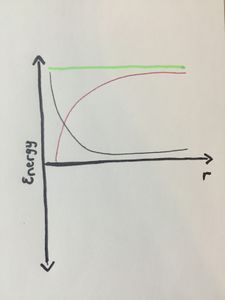
Example 2:
A proton and an electron start out far apart. Their initial velocities are nonzero, and their interaction is attractive.
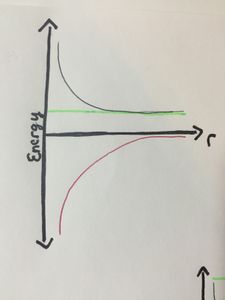
Example 3:
A daughter has just enough energy to escape from her controlling mother (they have an attractive relationship).

Solution
Example 1:
Example 2:
Example 3:
Middling
Question
Label K, U, and K+U on the following energy graphs. THEN, label the following three energy graphs 1, 2, or 3 based on the following scenarios:
1: One of the components of this energy graph is incorrect.
2: A proton and an electron are at rest, and they start out infinitely far apart.
3: An astronaut orbits the moon.
Solution
Example 1:
K+U is incorrect!
Example 2:
Example 3:
Difficult
Question
Create an energy graph for each of the following situations.
Situation 1: A spacecraft is orbiting a moon. The spacecraft is given an initial velocity that allows the spacecraft to leave the moon's orbit with a final velocity greater than zero.
Situation 2: A boy jumps onto a merry-go-round and is attracted to the merry-go-round's axle. The boy's initial velocity is not large enough for him to escape the merry-go-round, so he continues to "orbit" the merry-go-round.
Situation 3: Two people are repulsed by one another and are trying to fight. They are held at rest by two of their friends a finite distance apart, and they, of course, move away from one another as soon as they are released, since their friends will not let them approach one another.
Situation 4: A spring with a spring constant of k and has an initial length of l. It is stretched to length S and is released.
Situation 4a: The spring in situation 4 is again stretched and released. However, the spring is no longer an ideal system and is now subject to air resistance and friction.
Solution
Situation 1:
Situation 2:
Situation 3:
Situation 4:
Situation 4a:
Connectedness
Being able to figure out how much kinetic energy you can get from a given source is import to everyday life. The vehicles and machinery that transport and process essential goods such as water, food, and fuel need to convert chemical potential energy into kinetic energy to drive motors. The efficiency of this conversion helps save people money and reduce environmental damage. Additionally, the satellite that we rely on for GPS navigation is a direct implementation of bound systems. As the satellite orbits Earth, the potential and kinetic energy will change as the orbit will not be completely circular. K+U will be negative as the satellite is bound to the Earth.
Why is the discovery of energy so important? Energy and the conservation of energy drive our everyday lives. Everything we touch, eat, drink, and use has energy! Without energy, there would be no life as we know it. The laptop you are using right now? Potential energy. Your hand scrolling through this page? Kinetic energy. Everything has energy! And these energy graphs are a great way to help us learn how to interpret energy in different situations. How is energy related to my future? How is energy related to the things I am passionate about? How are energy and physics related to biochemistry, medical school, and surgery? In order to get into medical school, I must first take the MCATs. Physics and math majors score the highest on the MCATs, so physics is extremely important to master in order to successfully master the MCATs. Energy is everywhere, so I need to understand energy in order to be successful in the future. Physics is a part of everyday life. Energy is a part of everyday life. Mastering both now will only aid me in my dream of becoming a surgeon. From medical school student to intern, to surgical resident, to, one day, a surgeon, energy and physics will follow me. Energy graphs help to explain different energy interactions and make understanding energy simpler. Energy is a part of every scalpel I will hold, and kinetic energy will push me through the late nights and long shifts in my future. Is energy applicable to my future? Is energy applicable to medicine and surgery? Absolutely! Physics is more applicable to every aspect of my life than I ever could have imagined. - Julianne Oliver (Fall 2015).
History
Gustave-Gaspard Coriolis first described "kinetic energy" in 1829, and William Rankine coined the term "potential energy" in 1853.
Energy was proven mathematically in 1918.
Emmy Noether (1882-1935) uncovered the fundamental justification for conservation laws.
See Also
Further reading
Matter and Interactions 4th Edition by Ruth W. Chabay and Bruce A. Sherwood
- Section 6.10
External links
Gravitational Potential Energy
References
Matter and Interactions 4th Edition by Ruth W. Chabay and Bruce A. Sherwood
Chabay, R. W. & Sherwood, B. A. (2015). Matter and interactions. North Carolina State University: John Wiley & Sons, Inc.
Physics 2211 Test 3 (Fall 2015)
https://en.wikipedia.org/wiki/History_of_energy
Physics 2211 lecture notes (Fall 2015)
Physics 2211 labs via WebAssign (Fall 2015)
Physics 2211 labs (Fall 2018)
